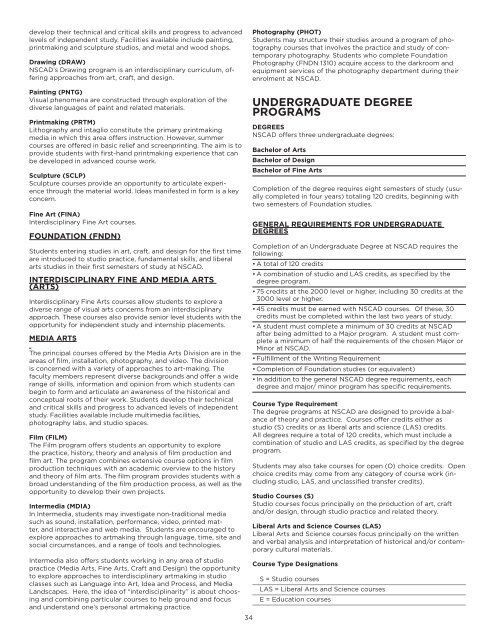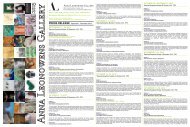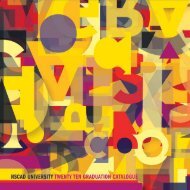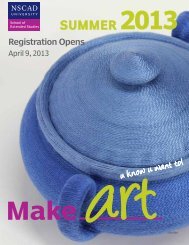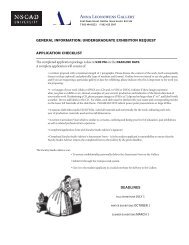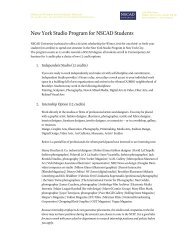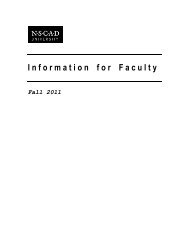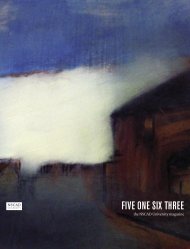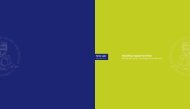CONTENTS - Nova Scotia College of Art and Design
CONTENTS - Nova Scotia College of Art and Design
CONTENTS - Nova Scotia College of Art and Design
Create successful ePaper yourself
Turn your PDF publications into a flip-book with our unique Google optimized e-Paper software.
develop their technical <strong>and</strong> critical skills <strong>and</strong> progress to advanced<br />
levels <strong>of</strong> independent study. Facilities available include painting,<br />
printmaking <strong>and</strong> sculpture studios, <strong>and</strong> metal <strong>and</strong> wood shops.<br />
Drawing (DRAW)<br />
NSCAD’s Drawing program is an interdisciplinary curriculum, <strong>of</strong>fering<br />
approaches from art, craft, <strong>and</strong> design.<br />
Painting (PNTG)<br />
Visual phenomena are constructed through exploration <strong>of</strong> the<br />
diverse languages <strong>of</strong> paint <strong>and</strong> related materials.<br />
Printmaking (PRTM)<br />
Lithography <strong>and</strong> intaglio constitute the primary printmaking<br />
media in which this area <strong>of</strong>fers instruction. However, summer<br />
courses are <strong>of</strong>fered in basic relief <strong>and</strong> screenprinting. The aim is to<br />
provide students with first-h<strong>and</strong> printmaking experience that can<br />
be developed in advanced course work.<br />
Sculpture (SCLP)<br />
Sculpture courses provide an opportunity to articulate experience<br />
through the material world. Ideas manifested in form is a key<br />
concern.<br />
Fine <strong>Art</strong> (FINA)<br />
Interdisciplinary Fine <strong>Art</strong> courses.<br />
FOUNDATION (FNDN)<br />
Students entering studies in art, craft, <strong>and</strong> design for the first time<br />
are introduced to studio practice, fundamental skills, <strong>and</strong> liberal<br />
arts studies in their first semesters <strong>of</strong> study at NSCAD.<br />
INTERDISCIPLINARY FINE AND MEDIA ARTS<br />
(ARTS)<br />
Interdisciplinary Fine <strong>Art</strong>s courses allow students to explore a<br />
diverse range <strong>of</strong> visual arts concerns from an interdisciplinary<br />
approach. These courses also provide senior level students with the<br />
opportunity for independent study <strong>and</strong> internship placements.<br />
MEDIA ARTS<br />
The principal courses <strong>of</strong>fered by the Media <strong>Art</strong>s Division are in the<br />
areas <strong>of</strong> film, installation, photography, <strong>and</strong> video. The division<br />
is concerned with a variety <strong>of</strong> approaches to art-making. The<br />
faculty members represent diverse backgrounds <strong>and</strong> <strong>of</strong>fer a wide<br />
range <strong>of</strong> skills, information <strong>and</strong> opinion from which students can<br />
begin to form <strong>and</strong> articulate an awareness <strong>of</strong> the historical <strong>and</strong><br />
conceptual roots <strong>of</strong> their work. Students develop their technical<br />
<strong>and</strong> critical skills <strong>and</strong> progress to advanced levels <strong>of</strong> independent<br />
study. Facilities available include multimedia facilities,<br />
photography labs, <strong>and</strong> studio spaces.<br />
Film (FILM)<br />
The Film program <strong>of</strong>fers students an opportunity to explore<br />
the practice, history, theory <strong>and</strong> analysis <strong>of</strong> film production <strong>and</strong><br />
film art. The program combines extensive course options in film<br />
production techniques with an academic overview to the history<br />
<strong>and</strong> theory <strong>of</strong> film arts. The film program provides students with a<br />
broad underst<strong>and</strong>ing <strong>of</strong> the film production process, as well as the<br />
opportunity to develop their own projects.<br />
Intermedia (MDIA)<br />
In Intermedia, students may investigate non-traditional media<br />
such as sound, installation, performance, video, printed matter,<br />
<strong>and</strong> interactive <strong>and</strong> web media. Students are encouraged to<br />
explore approaches to artmaking through language, time, site <strong>and</strong><br />
social circumstances, <strong>and</strong> a range <strong>of</strong> tools <strong>and</strong> technologies.<br />
Intermedia also <strong>of</strong>fers students working in any area <strong>of</strong> studio<br />
practice (Media <strong>Art</strong>s, Fine <strong>Art</strong>s, Craft <strong>and</strong> <strong>Design</strong>) the opportunity<br />
to explore approaches to interdisciplinary artmaking in studio<br />
classes such as Language into <strong>Art</strong>, Idea <strong>and</strong> Process, <strong>and</strong> Media<br />
L<strong>and</strong>scapes. Here, the idea <strong>of</strong> “interdisciplinarity” is about choosing<br />
<strong>and</strong> combining particular courses to help ground <strong>and</strong> focus<br />
<strong>and</strong> underst<strong>and</strong> one’s personal artmaking practice.<br />
34<br />
Photography (PHOT)<br />
Students may structure their studies around a program <strong>of</strong> photography<br />
courses that involves the practice <strong>and</strong> study <strong>of</strong> contemporary<br />
photography. Students who complete Foundation<br />
Photography (FNDN 1310) acquire access to the darkroom <strong>and</strong><br />
equipment services <strong>of</strong> the photography department during their<br />
enrolment at NSCAD.<br />
UNDERGRADUATE DEGREE<br />
PROGRAMS<br />
DEGREES<br />
NSCAD <strong>of</strong>fers three undergraduate degrees:<br />
Bachelor <strong>of</strong> <strong>Art</strong>s<br />
Bachelor <strong>of</strong> <strong>Design</strong><br />
Bachelor <strong>of</strong> Fine <strong>Art</strong>s<br />
Completion <strong>of</strong> the degree requires eight semesters <strong>of</strong> study (usually<br />
completed in four years) totaling 120 credits, beginning with<br />
two semesters <strong>of</strong> Foundation studies.<br />
GENERAL REQUIREMENTS FOR UNDERGRADUATE<br />
DEGREES<br />
Completion <strong>of</strong> an Undergraduate Degree at NSCAD requires the<br />
following:<br />
• A total <strong>of</strong> 120 credits<br />
• A combination <strong>of</strong> studio <strong>and</strong> LAS credits, as specified by the<br />
degree program.<br />
• 75 credits at the 2000 level or higher, including 30 credits at the<br />
3000 level or higher.<br />
• 45 credits must be earned with NSCAD courses. Of these, 30<br />
credits must be completed within the last two years <strong>of</strong> study.<br />
• A student must complete a minimum <strong>of</strong> 30 credits at NSCAD<br />
after being admitted to a Major program. A student must complete<br />
a minimum <strong>of</strong> half the requirements <strong>of</strong> the chosen Major or<br />
Minor at NSCAD.<br />
• Fulfillment <strong>of</strong> the Writing Requirement<br />
• Completion <strong>of</strong> Foundation studies (or equivalent)<br />
• In addition to the general NSCAD degree requirements, each<br />
degree <strong>and</strong> major/ minor program has specific requirements.<br />
Course Type Requirement<br />
The degree programs at NSCAD are designed to provide a balance<br />
<strong>of</strong> theory <strong>and</strong> practice. Courses <strong>of</strong>fer credits either as<br />
studio (S) credits or as liberal arts <strong>and</strong> science (LAS) credits.<br />
All degrees require a total <strong>of</strong> 120 credits, which must include a<br />
combination <strong>of</strong> studio <strong>and</strong> LAS credits, as specified by the degree<br />
program.<br />
Students may also take courses for open (O) choice credits. Open<br />
choice credits may come from any category <strong>of</strong> course work (including<br />
studio, LAS, <strong>and</strong> unclassified transfer credits).<br />
Studio Courses (S)<br />
Studio courses focus principally on the production <strong>of</strong> art, craft<br />
<strong>and</strong>/or design, through studio practice <strong>and</strong> related theory.<br />
Liberal <strong>Art</strong>s <strong>and</strong> Science Courses (LAS)<br />
Liberal <strong>Art</strong>s <strong>and</strong> Science courses focus principally on the written<br />
<strong>and</strong> verbal analysis <strong>and</strong> interpretation <strong>of</strong> historical <strong>and</strong>/or contemporary<br />
cultural materials.<br />
Course Type <strong>Design</strong>ations<br />
S = Studio courses<br />
LAS = Liberal <strong>Art</strong>s <strong>and</strong> Science courses<br />
E = Education courses


